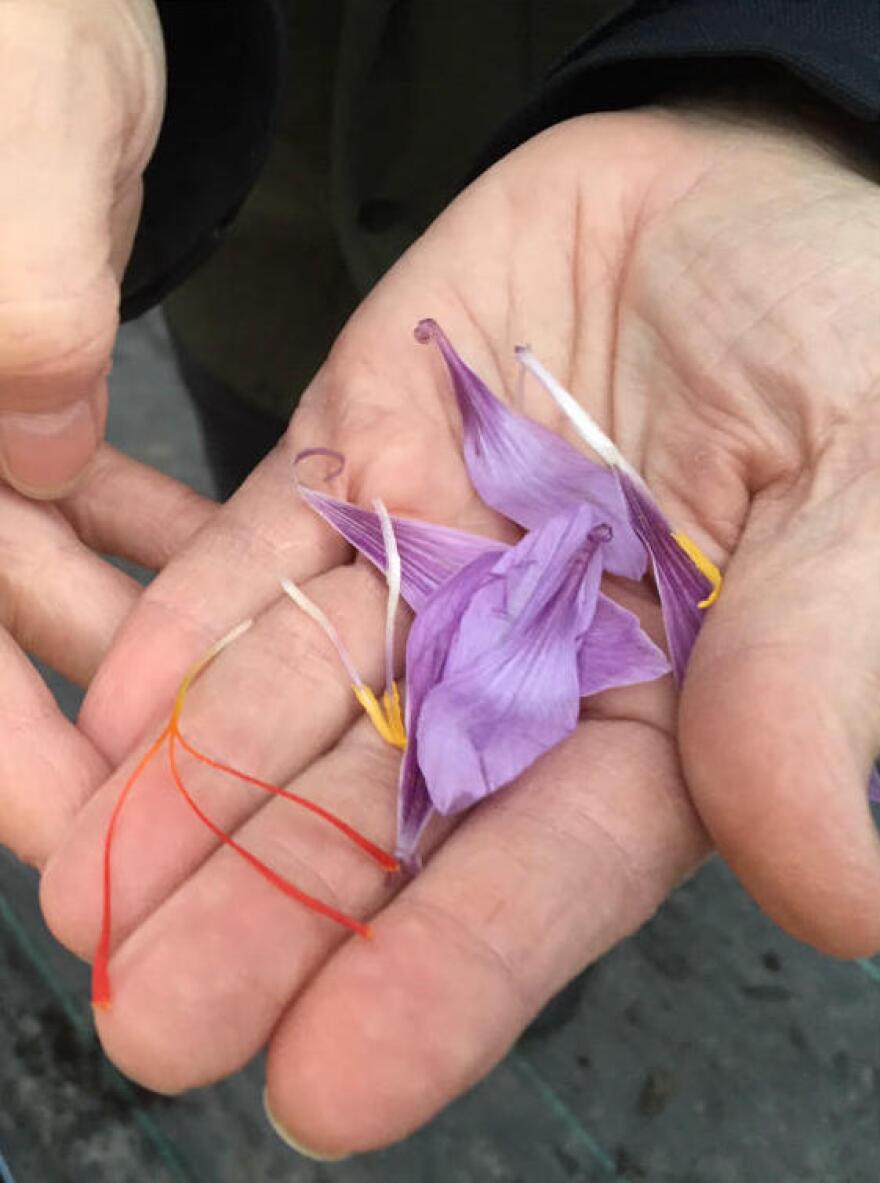The exotic spice saffron is garnering more and more attention among farmers and growers in Vermont and across New England.
The increased interest began about six months ago, when word got around that University of Vermont researchers had produced yields of saffron that were at least three times greater than in the traditional saffron-growing regions of Iran and Spain.
The UVM researchers, Dr. Margaret Skinner and post-doctoral student Arash Ghalehgolabbehbahani, have been growing the saffron crocus inside a greenhouse-like structure at a research station in St. Albans.
On a cold, blustery day back in November, Skinner described the pale purple flowers in full bloom.
“Each flower has six petals. It has three stamens — those are the mustard yellow ones. And there are the three stigmas — that is the gold!" she said as she admired the powdery threads of the deep, golden-orange saffron.
And "gold" seemed to be a common theme at a workshop Skinner and Ghalehgolabbehbahani held this month for people interested in growing saffron, which is considered to be the world’s most expensive spice. Dr. Skinner says the event filled up early and people came from across the northeast and from as far away as California.
"Literally, on a per-gram basis, it's more expensive than gold.” — Scott Beatty, Food Future, Cambridge, Mass.
Ryan Golembeske was at the UVM workshop with family members who have a small farm in Little Compton, Rhode Island. “When Mom found out about saffron we were like, ‘That’s too good to be true,’" Golembeske said. "And now we’re like, ‘Wow, [we] have to check it out because if it is real, then this is the gold rush!'"
Golembeske was excited to hear that, by all accounts, the market for saffron is vast.
“And then on top of that, your first crop — as long as you don’t plant when the ground is frozen — you’re still guaranteed a return," he said. "And most of the time when you plant or grow, that’s not how things work."
“It's worth more than gold right now," said workshop participant Scott Beatty. "Literally, on a per-gram basis, it's more expensive than gold.”

Beatty is with Food + Future in Cambridge, Massachusetts, a group funded in part by the MIT Media Lab. Beatty says that because there’s such a big market for saffron and because it is so high-priced, it does get adulterated in the world marketplace. And that’s where Vermont comes in.
“I think this is an incredible opportunity for Vermont in my opinion because saffron is the fourth most fraudulent crop in the food world," Beatty says. “A Vermont co-op center on saffron could be amazing … you could establish its provenance. It would be incredibly high quality. From Arash [Ghalehgolabbehbahani's] research that I’ve seen, I know the saffron content is high.”
The message over the course of the day-long workshop was that saffron can be grown here. The UVM research has involved planting the saffron crocus in a high tunnel — similar to a greenhouse, but without heat.
Dr. Skinner believes it's an ideal crop to add to farming operations for a number of reasons.
Saffron is harvested in the late fall, when other crops are done, and can be grown on a large or small scale, in unpredictable climate conditions.
“We’re starting to build a whole network nationwide — that together, we can work to make saffron production a reality throughout much of the U.S. and Canada,” Skinner says.
"We're starting to build a whole network nationwide ... Together, we can work to make saffron production a reality throughout much of the U.S. and Canada." — Dr. Margaret Skinner, UVM
There are challenges to growing saffron — rodents, for one, love to eat the plant. But Skinner says people are already developing strategies to control the varmints, and they see a bright future for saffron.
“And it truly is a golden opportunity for growers, and they know it," Skinner says. "And they’re enthusiastic to get going with it."
Just how enthusiastic?
The family from Palmer Farm in Little Compton, Rhode Island, says it will get started immediately.
"We’ll definitely look at buying the saffron corms and moving forward with it,” Nancy Fontaine says. "And I'm going to contact the [U.S. Department of Agriculture] and see if they'll help us – they should help us."
Meanwhile, a new North American Center for Saffron Research and Development has been established — in response, Dr. Skinner says, to the overwhelming interest of growers and the public.




